Content [show]
Experienced gardeners have long been using not only beautiful, but also useful plants and shrubs for planting in their summer cottage. Thus, thuja gained popularity - an evergreen perennial plant that releases phytoncides into the atmosphere, which have antimicrobial properties.
Planting and caring for thuja outdoors for experienced gardeners is not difficult. That is why thuja can also be planted at home, where the features of care may differ slightly.

Types and varieties of thuja
There are a huge number of species and varieties of the presented plant. There are 5 main types, which include:
- Chinese;
- Korean;
- Japanese;
- west;
- folded.
Each of the species includes up to several dozen varieties, but only the most unpretentious representatives are suitable for growing in garden plots.
The following are distinguished here:
Thuja spherical
- it was due to the shape of the crown that it received its portion of popularity in cultivation in summer cottages.
Danike is one of the most popular varieties with a spherical crown.
... They prefer to plant it near gazebos or try to dilute the created woody composition. This variety reaches a height of
60 cm
, which makes it attractive in appearance and easy to clean.
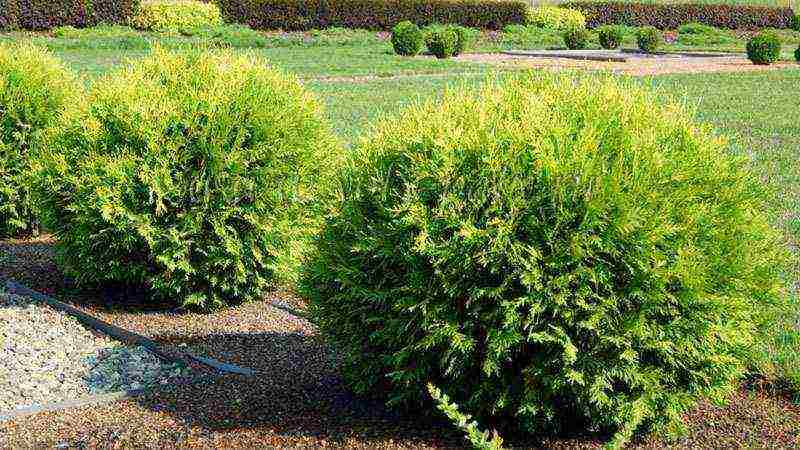 Thuja Brabant
Thuja Brabant
- a cone-shaped plant variety that can grow 40 cm in height and increase in size up to 15 cm in diameter in a year. This variety, when grown in summer cottages in Russia, can reach a height of all
4
or even
5 m
... Therefore, it is used less often. Such bushes can be found in the garden plots of elite residences, where thuja plays the role of a hedge.
 Thuja Smaragd
Thuja Smaragd
- the same conical crown shape attracts most gardeners. An adult bush in diameter reaches
2 m
... The crown is quite dense, so it can also be used as a hedge. The presented variety pleases with its longevity - the shrub can grow up to 150 years.

Each type and variety of thuja Deserves attention. They need to be studied due to the need or desire to plant a particular variety in the garden. Such actions are necessary for the normal and full growth of the plant.
Which is better: juniper or thuja? Video:
Breeding methods and cultivation features
The shrub is grown at home, and only then planted in open ground in the garden.
You can use a simple and easier way - to purchase a ready-made seedling, which must be planted immediately after purchase. But self-cultivation is much more interesting.
So, you can grow thuja from a seed or from a selected cuttings. Both methods are worthy of detailed consideration.

Growing a seedling from seed
If you are new to gardening, then the question is, how to grow thuja from seeds, should be considered in more detail. The seeds of the presented plant can be purchased at a specialized store or you can get it yourself.
Thuja has woody cones, from which seeds are extracted from September to December.
Cones are placed in a ventilated place under diffused light. After a while, they open, and you can safely remove the seeds.
Further growing thuja from seeds at home happens as follows:
1. The first method of planting seeds involves using a regular flower pot and soil mixed with peat and humus.
Previously, the seeds are kept for a day in a damp cloth. You should not plant the seeds deeply, just sprinkle them with earth or sawdust on top.
As necessary, the planted seeds are watered (with drying out of the soil) and kept under diffused light. Sprouts should be planted with warming up the soil in the garden in the spring.

2. The second method of planting seeds gives a germination rate of about 90%. Here, in September, you should remove the seeds from the cones and put them in a bag, which must be stored in a cool place until it snows.
As soon as the snow completely covers the earth's surface, the seeds are buried in snowdrifts and kept there until spring. In the spring, it is already possible to plant the preserved thuja seeds also shallowly into the soil of the garden plot at a distance of 10 cm. It is important to water the garden abundantly.
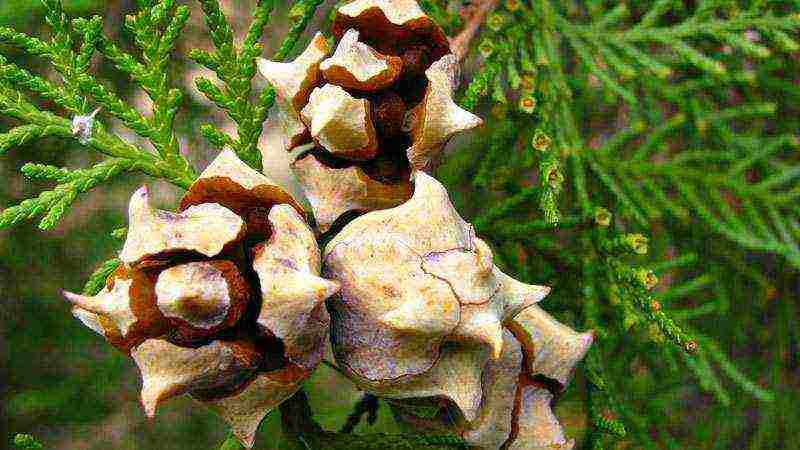
Thus, sprouts grow for 3 years, taking care of them properly - removing weeds and regularly watering as the soil dries up. In the fourth spring, you can plant the sprouts in a permanent place.
From the above, it becomes clear that such a cultivation takes a long time.
Therefore, gardeners resort to the second method of self-growing seedlings using cuttings.
Growing a seedling from a twig
How to grow thuja from a twig, if there is no plant presented on your garden plot?
In April, when the buds are ripe on the branches of the plants, visit a fruit tree nursery or visit your neighbors whose garden is decorated with this unique and interesting shrub. Ask to cut a lignified stalk about 40 cm in size.
Then you will need to perform the following actions:
- Divide the stalk yourself into 2-4 specimens so that each of them has a part of the mother bark.
- The resulting branches must be treated with any solution that stimulates rooting, and left for 12 hours to process.
- Prepare the soil in your garden - add some peat and sand to the soil.
- Plant the cuttings into the ground to a depth of no more than 3 cm.
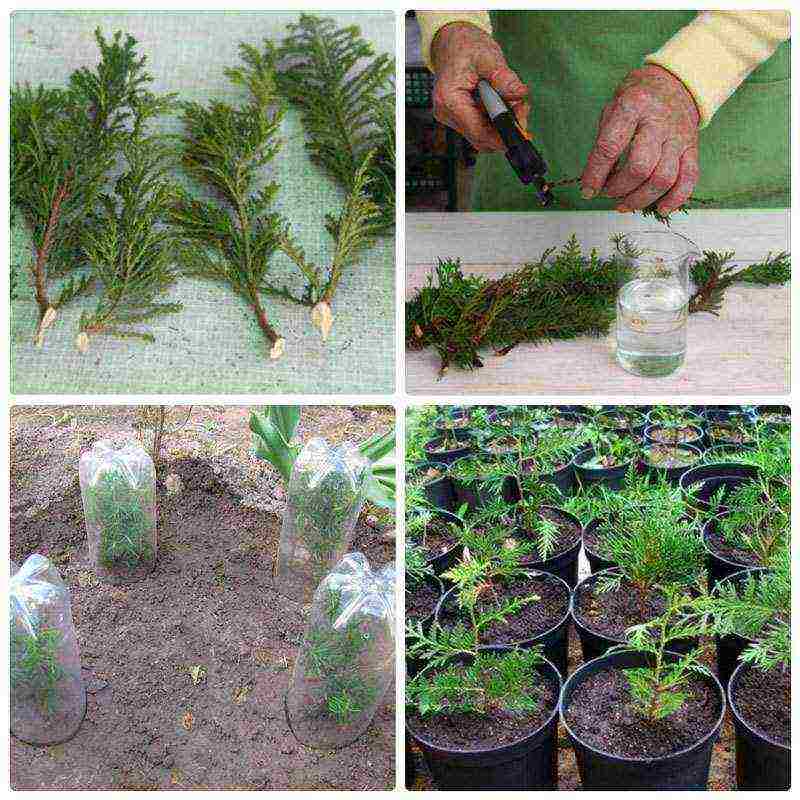
- The soil should be well moistened, but also do not forget about spraying - this is an important condition in the presented method of growing a seedling. When the cuttings are rooted, watering is significantly reduced.
- For the winter, new mini-shrubs are covered with polyethylene if the planting took place in a region with a harsh climate. In other cases, it will be enough to cover with fallen leaves or spruce branches.
Similar thuja propagation by cuttings can be done at home. Branches are planted in a container with soil and covered with a greenhouse - such an action will lead to faster growth.
Just do not forget about the appropriate daily airing, watering and spraying until the cuttings are completely rooted.
How to propagate and grow thuja, video:
Correct planting and care of thuja outdoors
Thuja planting depends on the size of self-grown seedlings. If an acquired plant is planted, then this is done according to the following principles:
- A place for further growth of thuja should have a beneficial effect on the growth of the plant - it is a sunny place, protected from the winds. You should not choose a place on the site that is constantly exposed to direct sunlight - the plant will begin to wither.Also, you can not plant a shrub in the shade - it will begin to thin out.
- The dimensions of the dug hole for planting depend only on the existing root system. The diameter of the planting pit can be up to a meter.
- A layer of stones is laid at the bottom of the hole as drainage - the presented plant does not tolerate stagnant water well.
- A layer of soil is laid on top of the stones, where turf, peat and sand are mixed in equal quantities.
- Now you should set the seedling so that the root collar is at the level of the soil.
- "Fix" the seedling with the remaining soil or turf soil.
- After planting, the seedlings can be watered with a moderate amount of water.
When planting, the distance between the seedlings should be observed. Depending on the variety, it can reach from 2 to 5 m. Consider the possible diameter of the type of shrub used.
This is especially necessary to do if it is implied thuja hedge... In this case, the distance is calculated without taking into account the free space between the future grown bushes.
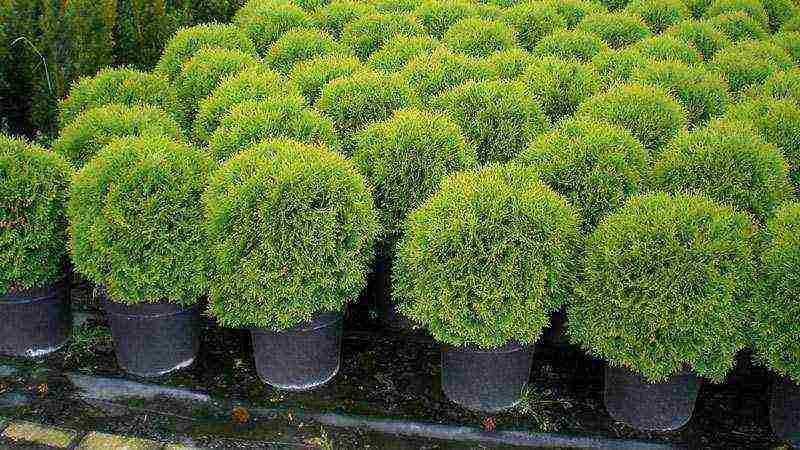
As for the care of thuja in the open field, difficulties are not foreseen here. It is important to regularly water the shrub, which is done as the soil dries. Periodically, the soil can be hilled, and it is also necessary to constantly remove the weed.
Top dressing of the plant is carried out in early spring, when snow covers the surface of the soil. At this time, nitrogen fertilizers are used.
Such procedures are carried out until mid-summer no more than 2 times a month. Next, you should resort to the use of potash fertilizers, feeding which is extended until late autumn.
At 2-3 years of age, thuja shrubs may require pruning, the whole principle of which is to give an attractive and correct crown for this shrub.
As a rule, in the early years, pruning is only preventive. The full formation of the bush is carried out already in adult specimens.
How to plant thuja correctly, video:
Thuja: home care
In the absence of your own garden plot, you can grow a small miniature tree at home. Thuja in a pot today it does not seem strange, but quite an adequate solution for those flower growers who want to have a coniferous plant in their home.
There are no additional aspects to care here. It is only important to carry out timely watering and provide the plant with fertile and nutritious soil.
For planting the presented plant at home, choose the eastern thuja and the Ploskovetochnik variety. Planting a plant for self-cultivation in a pot is carried out according to the same principle as described above.
An exception is the absence of a transplantation point to a permanent place - after planting a seed or cutting in a pot with soil, the plant remains in place until fully ripe. The small volume of the container will not allow the shrub to grow as high and wide as possible.
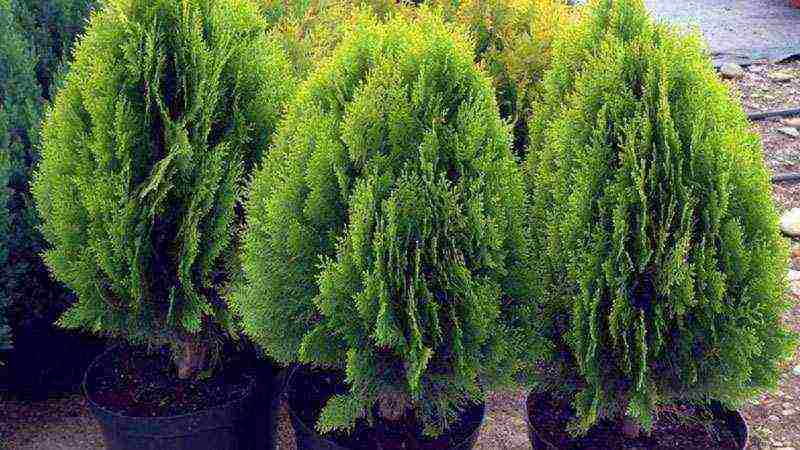
Principle, how to care for thuja at home, is enclosed in the following order:
- Planting a plant in a pot requires good drainage at the bottom of the pot. You can use a regular tray, which will also help remove excess moisture.
- The soil can be enriched with useful microelements by mixing four parts of sod land with two parts of coniferous. Only part of the sand is added to the mixture - the result is a soil suitable for planting seeds or cutting.
- The pot must be placed on a north or west window - this will provide diffused light suitable for normal growth for the shrub.
- For optimal cultivation, an already mature tree is provided with a temperature of 10-15 ° C. In the summertime, it is necessary to take the pot with the plant to the balcony so that it receives its portion of air procedures.
- Watering is carried out as needed as soon as the soil dries out. It is important not to allow excessive moisture or dry out of the soil, all this will lead to the death of the plant.
- Thuja can calmly tolerate any whims of air humidity in the room.However, excessive "air drying" should not be allowed. It is better to maintain a moderate climate in relation to indoor humidity. In summer, in the heat, the plant should be sprayed.
- For the normal formation of a bush, the plant is pruned.
When growing thuja, one should not forget about timely feeding with special universal fertilizers, which are carried out in the spring and during the summer for a favorable and rapid growth.
From August to September, you can start propagation by cuttings.
Self-forming bonsai
Surprisingly, some growers give the bush-like thuja the shape of a bonsai tree. This is not easy to do. It is not enough just to pinch and cut the plant.
To form a bonsai, it is necessary to give the shrub an appropriate shape, subjecting its branches to a forced change in the direction of growth, slightly breaking them at the same time. The curved branch is fixed in a new direction and all branches are cut off.
After a while, the shrub will begin to form into a bonsai tree, where you should monitor the formation of the crown, constantly pruning.
Pay attention to this material - Barberry: planting and care, useful properties.
Diseases and pests
Proper care of the presented plant allows you to achieve an attractive green shrub.
If you make any mistakes, the thuja branches can thin out, and the rich green color will change to pale gray.
But this is not the worst thing that can happen to a plant. Much more dangerous is a fungal infection or an invasion of harmful insects, the fight against which can take a long time. The most common and dangerous diseases of thuja include:
You will be interested in this article - Black currant: planting and care in the open field.
- Fungus - appears in the form of spots characteristic of the fungus, often affecting young shoots. The shrub should be treated immediately. To begin with, all affected areas are completely cut off, and then you can resort to treatment with any antifungal solution.
- False shield - yellow spots form on the branches, which are often perceived as a real shield. To remove them, the plant should be treated with Rogor or Karbofos solutions.

- Speckled moth - often appears when growing thuja outdoors. It manifests itself in the form of the transformation of branches into brown color and the withering away of the top of the tree. You can get rid of pests by treating the shrub with solutions containing pyrethroid.
- Aphids - leads to the fall of the needles from the bush. Here you can use Karbofos according to the instructions.
The correct cultivation of a coniferous plant at home or in the open field will give flower growers and gardeners great pleasure.
Such plants should be "kept" nearby, as thuja needles have excellent beneficial properties.
Thuja needles can be used to treat wounds, as a hemostatic agent, and also for colds.
Like the article ? Show it to your friends:
Among the variety of conifers, thuja is especially loved by summer residents, owners of private houses. This is not surprising - thuja is frost-resistant, unpretentious, aesthetically attractive. Planting and care in the open field will not require significant work from the summer resident, but its presence on the site will be positive from any point of view. It is great for the formation of hedges, with its help you can create unique green shapes for landscape design of the site, arrange paths.
This tree, like its coniferous counterparts, exudes a wonderful aroma, enriches the air with useful phytoncides. Thuja carries a lot of positive qualities.
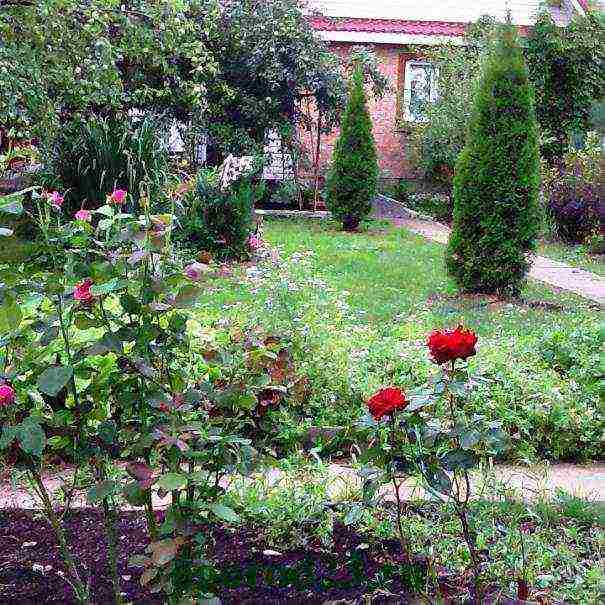
Thuja differs from pine or spruce in that it has no needles, its branches are covered with small green scales, soft, pleasant to the touch. It is tacitly called the "royal tree" - it is well deserved.We will consider the nuances of planting, caring for the coniferous beauty thuja, so that it takes root on your site too.
↑ to contents ↑ Thuja tree - selection of seedlings
If you do not plan to reproduce thuja independently, then you can purchase ready-made, grown seedlings. They can be purchased from ephedra nurseries or specialist shops. There, among the declared assortment, you will choose the desired variety, buy a healthy tree, adapted to the local climate.
They can be purchased from ephedra nurseries or specialist shops. There, among the declared assortment, you will choose the desired variety, buy a healthy tree, adapted to the local climate.
Small thuja from nurseries vary in size and age. If you have a small seedling, then it will not be difficult to "grow" it yourself until it is planted in a permanent place of growth. You can also purchase a large copy, ready for the decoration of the site or the local area.
When choosing, always pay attention to the conditions of the plants, the degree of soil moisture in the containers, the strength of the coniferous scales on the branch. The branches of the seedlings should be elastic, the needles should not crumble, they should not have any spots or signs of disease. Upon arrival home, hurry up to transplant them to a shaded place, water.
↑ back to contents ↑ Planting thuja in the ground
Thuja will perfectly take root on your site at any time of the year, except in late autumn or winter. Experienced gardeners advise exactly the spring period - April, May. Planted in spring, it will hurt less, grow faster, and adapt better to the environment.
The landing site should be slightly shaded, consider this factor when planning the landscape design of the site. In direct sunlight, the tree will wither, and subsequently it will be worse to endure the winter cold. In a completely dark place, thuja will slowly develop, the branches will not be lush, bright. The ideal territory for it will be a windless section of the site, with light shading, close occurrence of groundwater.
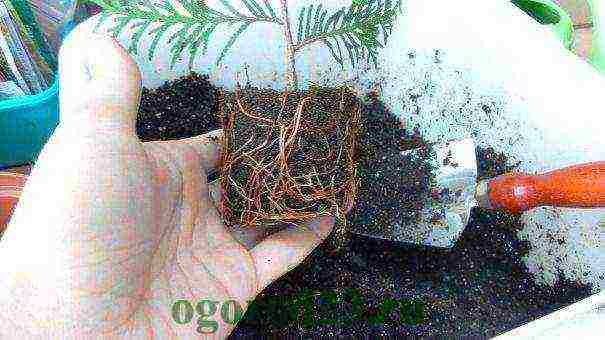
Thuja - planting and leaving, phased actions:
- First, we dig a rather deep hole - 80-100 cm deep, with the same diameter dimensions (if you, of course, have a large seedling, and not the one in the photo above). The deepening should be such that a tree with an earthen lump can freely enter there. At the bottom we pour a little earth mixed with wood ash or other organic fertilizer.
- We put it in a hole, while its root collar should be at the same level with the soil surface.
- Mix the dug earth with sand, peat (1: 1), fill a depression with a seedling with this mixture, and then slightly trample.
The distance between the trees should be determined according to the characteristics of the variety, since thuja are very small and, conversely, very tall. Small trees can be planted a meter apart, large trees about 4-5 meters. Some varieties of thuja reach 15-20 meters in height, and their crown grows in breadth up to 3-4 meters (for example, thuja western Brabant). For full development, such a tree needs space, but when decorating alleys, green corridors, hedges, thuja are planted at a distance of 1 meter, regardless of the variety and type.
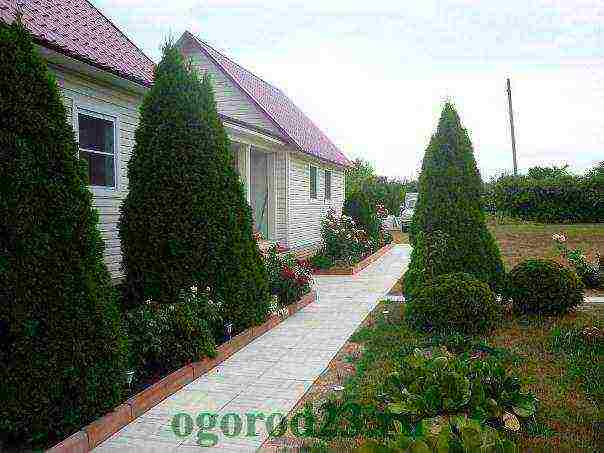 Tui Western Smaragd and globular Danica↑ back to contents ↑ How to care for thuja
Tui Western Smaragd and globular Danica↑ back to contents ↑ How to care for thuja
Competent care of this ephedra implies watering, feeding, loosening the trunk circle, and forming a crown. After the tree is planted at its permanent place of residence, primary feeding is done. For these purposes, natural growth stimulants are often used (most gardeners choose "Epin"). The ingredients of such dressings contribute to better rooting of the tree, improve resistance to diseases. In the spring, you can feed it with potassium-phosphorus supplements, it is better to do this twice, the break between fertilizers should be 10-15 days.
In spring, the frequency of irrigation is influenced by the amount of rain, with the onset of summer it is enough 2 times a week, in the spring - 1 time.If the rains are frequent, then there is no need to water, there will be enough rain moisture. Thuja requires high-quality watering at all stages of life (seedling, adult tree), while the crown also loves irrigation. In order for the branches to be elastic, shiny, to please you with the brightness of green shades, the minimum amount of water for the root area should be 10 liters per watering (once a week, if the summer is very dry, then up to 3 times). Determine the lack of moisture by the state of the top of the thuja - it begins to turn yellow. It is better to water the trees early in the morning or in the evening.
Tuya is very fond of irrigating the crown, for these procedures, the acquisition of a special nozzle becomes relevant. From such sprinkling, dust is washed off, a fresher appearance of the tree is provided, a pleasant coniferous aroma begins to stand out. Do not be afraid to overdo it with irrigation, 1-2 times a day will only benefit thuja.
Returning to fertilizers, it is worth noting that too frequent fertilizing for thuja is not required. Special mineral compositions for conifers (for example, "Fertika") or compost, which has already become a classic additive, is sufficient to use twice a season - in spring and summer. Fertilizers are applied during loosening: they are laid out in a near-trunk circle, and during plowing they are mixed with the top layer of the soil. In summer, the additive can be diluted with water and used for irrigation.
The near-trunk area must be periodically cleaned of weeds, loosened, mulched with sawdust or compost. Decoratively painted sawdust (they are painted with natural ingredients) or nutshells look very attractive. Mulching creates some barrier to weeds, retains moisture, and improves the condition of the tree as a whole.
As for haircuts or artistic pruning, it is better not to touch it for the first two years of a tree's life, it should take root in its place. You can start caring for the crown from the third year from the moment of planting. Initially, dried, weak branches are removed, and the degree of density is determined. Excessive thinning negatively affects the decorative qualities of the tree, everything should be in moderation.
The main pruning is carried out in April, and then only the shape is corrected. For high-quality air circulation, maintaining the "vigorous" appearance of thuja, gardeners recommend removing all branches of annual growth.
If the artistic intention requires the tree to grow in breadth, then only the upper part of the crown should be trimmed. From tui, you can create various geometric shapes, columns, figures of animals or fairy-tale characters. For beginner gardeners, it is quite easy to give the crown of a tree the shape of a ball, cascade, border. Trimming or pruning is best done in dry weather.
↑ to contents ↑ Tuya - preparation for winter
For colder regions of the country, frost-resistant varieties of tui (western) should be chosen. Despite their unpretentiousness, they also require preparation for the cold season. In the fall, it is necessary to provide the trees with abundant watering, since even in winter the thuja continues to develop, albeit at a slower pace.
In the first years of life, young representatives must be insulated. With the help of a dense plastic film, non-woven spunbond or other suitable covering material, a kind of cocoon is formed, which will retain heat and let the sun's rays through. You can even buy special covers designed for this very purpose, they are sold by the garden departments of supermarkets or online stores.
For the winter, the roots are covered with fallen leaves, which are harvested with the onset of spring, as soon as the upper layer of the earth thaws. The overgrown crowns of adult thujas are neatly tied with a wide ribbon to prevent the accumulation of snow on the branches.
To please the eye, there was a healthy thuja, planting and care in the open field should be done competently, in a timely manner.This tree is quite unpretentious, but the result of simple care is expressed not only by its external beauty, decoration of the territory. A green hedge made of thuja will absorb noise from the street, neighboring territories, and also protect your site from prying eyes.
Experienced gardeners have long been using not only beautiful, but also useful plants and shrubs for planting in their summer cottage. Thus, thuja gained popularity - an evergreen perennial plant that releases phytoncides into the atmosphere, which have antimicrobial properties.
Planting and caring for thuja outdoors for experienced gardeners is not difficult. That is why thuja can also be planted at home, where the features of care may differ slightly.

Types and varieties of thuja
There are a huge number of species and varieties of the presented plant. There are 5 main types, which include:
- Chinese;
- Korean;
- Japanese;
- west;
- folded.
Each of the species includes up to several dozen varieties, but only the most unpretentious representatives are suitable for growing in garden plots.
The following are distinguished here:
Thuja spherical
- it was due to the shape of the crown that it received its portion of popularity in cultivation in summer cottages.
Danike is one of the most popular varieties with a spherical crown.
... They prefer to plant it near gazebos or try to dilute the created woody composition. This variety reaches a height of
60 cm
, which makes it attractive in appearance and easy to clean.
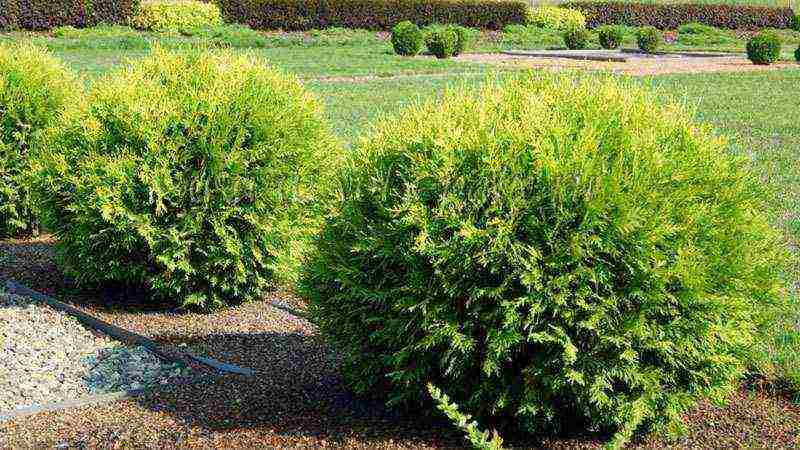 Thuja Brabant
Thuja Brabant
- a cone-shaped plant variety that can grow 40 cm in height and increase in size up to 15 cm in diameter in a year. This variety, when grown in summer cottages in Russia, can reach a height of all
or even
5 m
... Therefore, it is used less often. Such bushes can be found in the garden plots of elite residences, where thuja plays the role of a hedge.
 Thuja Smaragd
Thuja Smaragd
- the same conical crown shape attracts most gardeners. An adult bush in diameter reaches
2 m
... The crown is quite dense, so it can also be used as a hedge. The presented variety pleases with its longevity - the shrub can grow up to 150 years.
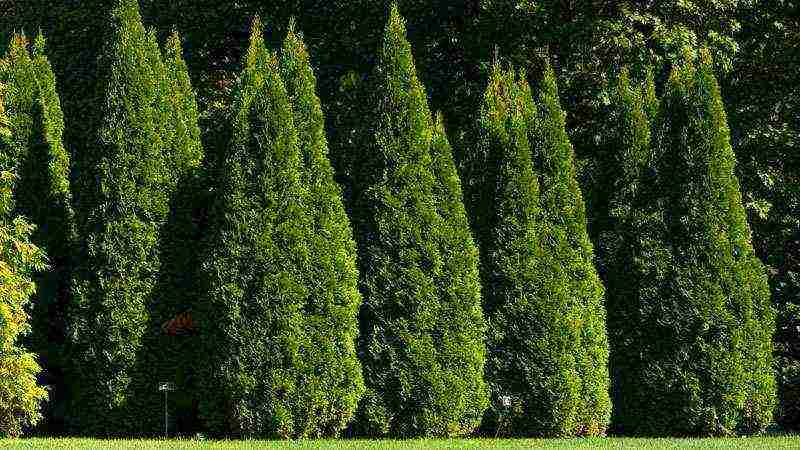
Each type and variety of thuja Deserves attention. They need to be studied due to the need or desire to plant a particular variety in the garden. Such actions are necessary for the normal and full growth of the plant.
Which is better: juniper or thuja? Video:
Breeding methods and cultivation features
The shrub is grown at home, and only then planted in open ground in the garden.
You can use a simple and easier way - to purchase a ready-made seedling, which must be planted immediately after purchase. But self-cultivation is much more interesting.
So, you can grow thuja from a seed or from a selected cuttings. Both methods are worthy of detailed consideration.

Growing a seedling from seed
If you are new to gardening, then the question is, how to grow thuja from seeds, should be considered in more detail. The seeds of the presented plant can be purchased at a specialized store or you can get it yourself.
Thuja has woody cones, from which seeds are extracted from September to December.
Cones are placed in a ventilated place under diffused light. After a while, they open, and you can safely remove the seeds.
Further growing thuja from seeds at home happens as follows:
1. The first method of planting seeds involves using a regular flower pot and soil mixed with peat and humus.
Previously, the seeds are kept for a day in a damp cloth. You should not plant the seeds deeply, just sprinkle them with earth or sawdust on top.
As necessary, the planted seeds are watered (with drying out of the soil) and kept under diffused light. Sprouts should be planted with warming up the soil in the garden in the spring.

2. The second method of planting seeds gives a germination rate of about 90%. Here, in September, you should remove the seeds from the cones and put them in a bag, which must be stored in a cool place until it snows.
As soon as the snow completely covers the earth's surface, the seeds are buried in snowdrifts and kept there until spring. In the spring, it is already possible to plant the preserved thuja seeds also shallowly into the soil of the garden plot at a distance of 10 cm. It is important to water the garden abundantly.
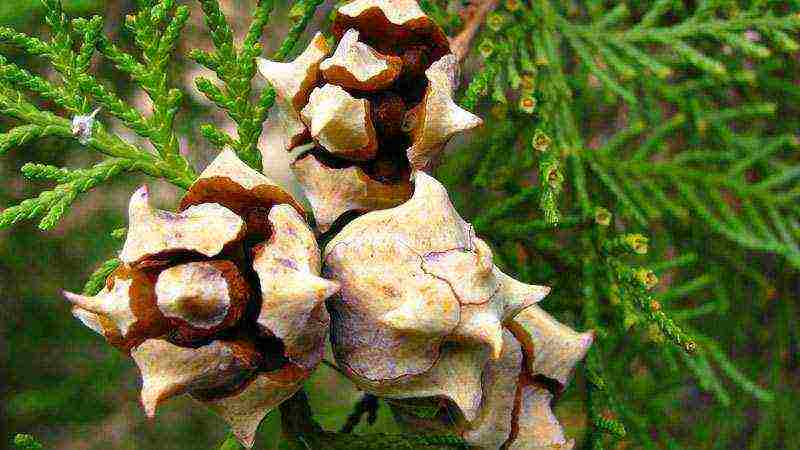
Thus, sprouts grow for 3 years, taking care of them properly - removing weeds and regularly watering as the soil dries up. In the fourth spring, you can plant the sprouts in a permanent place.
From the above, it becomes clear that such a cultivation takes a long time.
Therefore, gardeners resort to the second method of self-growing seedlings using cuttings.
Growing a seedling from a twig
How to grow thuja from a twig, if there is no plant presented on your garden plot?
In April, when the buds are ripe on the branches of the plants, visit a fruit tree nursery or visit your neighbors whose garden is decorated with this unique and interesting shrub. Ask to cut a lignified stalk about 40 cm in size.
Then you will need to perform the following actions:
- Divide the stalk yourself into 2-4 specimens so that each of them has a part of the mother bark.
- The resulting branches must be treated with any solution that stimulates rooting, and left for 12 hours to process.
- Prepare the soil in your garden - add some peat and sand to the soil.
- Plant the cuttings into the ground to a depth of no more than 3 cm.
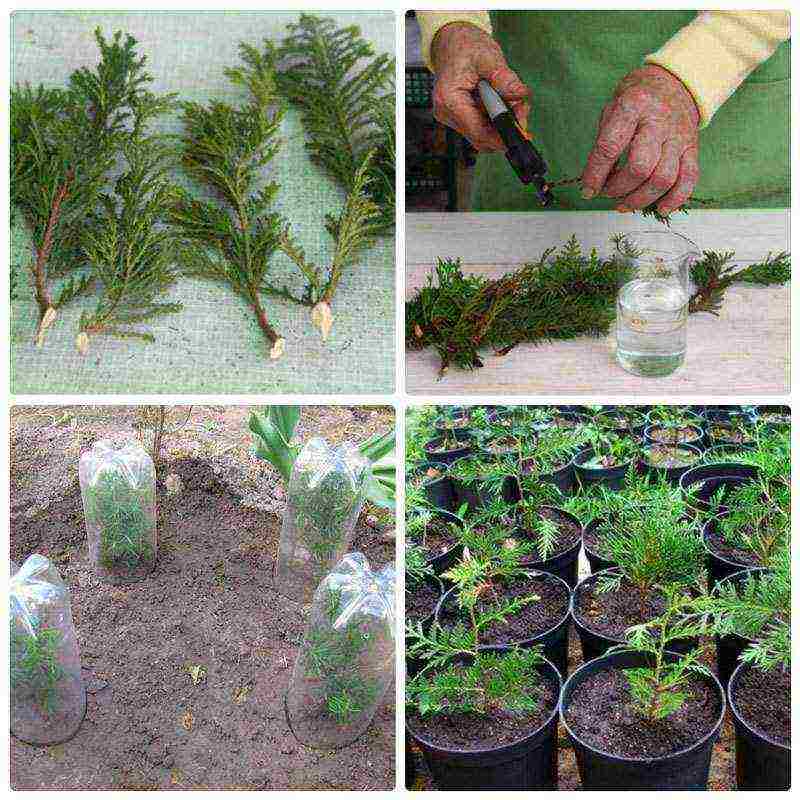
- The soil should be well moistened, but also do not forget about spraying - this is an important condition in the presented method of growing a seedling. When the cuttings are rooted, watering is significantly reduced.
- For the winter, new mini-shrubs are covered with polyethylene if the planting took place in a region with a harsh climate. In other cases, it will be enough to cover with fallen leaves or spruce branches.
Similar thuja propagation by cuttings can be done at home. Branches are planted in a container with soil and covered with a greenhouse - such an action will lead to faster growth.
Just do not forget about the appropriate daily airing, watering and spraying until the cuttings are completely rooted.
How to propagate and grow thuja, video:
Correct planting and care of thuja outdoors
Thuja planting depends on the size of self-grown seedlings. If an acquired plant is planted, then this is done according to the following principles:
- A place for further growth of thuja should have a beneficial effect on the growth of the plant - it is a sunny place, protected from the winds. You should not choose a place on the site that is constantly exposed to direct sunlight - the plant will begin to wither. Also, you can not plant a shrub in the shade - it will begin to thin out.
- The dimensions of the dug hole for planting depend only on the existing root system. The diameter of the planting pit can be up to a meter.
- A layer of stones is laid at the bottom of the hole as drainage - the presented plant does not tolerate stagnant water well.
- A layer of soil is laid on top of the stones, where turf, peat and sand are mixed in equal quantities.
- Now you should set the seedling so that the root collar is at the level of the soil.
- "Fix" the seedling with the remaining soil or turf soil.
- After planting, the seedlings can be watered with a moderate amount of water.
When planting, the distance between the seedlings should be observed. Depending on the variety, it can reach from 2 to 5 m. Consider the possible diameter of the type of shrub used.
This is especially necessary to do if it is implied thuja hedge... In this case, the distance is calculated without taking into account the free space between the future grown bushes.

As for the care of thuja in the open field, difficulties are not foreseen here. It is important to regularly water the shrub, which is done as the soil dries. Periodically, the soil can be hilled, and it is also necessary to constantly remove the weed.
Top dressing of the plant is carried out in early spring, when snow covers the surface of the soil. At this time, nitrogen fertilizers are used.
Such procedures are carried out until mid-summer no more than 2 times a month. Next, you should resort to the use of potash fertilizers, feeding which is extended until late autumn.
At 2-3 years of age, thuja shrubs may require pruning, the whole principle of which is to give an attractive and correct crown for this shrub.
As a rule, in the early years, pruning is only preventive. The complete formation of the bush is carried out already in adult specimens.
How to plant thuja correctly, video:
Thuja: home care
In the absence of your own garden plot, you can grow a small miniature tree at home. Thuja in a pot today it does not seem strange, but quite an adequate solution for those flower growers who want to have a coniferous plant in their home.
There are no additional aspects of care here. It is only important to carry out timely watering and provide the plant with fertile and nutritious soil.
For planting the presented plant at home, choose the eastern thuja and the Ploskovetochnik variety. Planting a plant for self-cultivation in a pot is carried out according to the same principle as described above.
An exception is the absence of a transplantation point to a permanent place - after planting a seed or cutting in a pot with soil, the plant remains in place until fully ripe. The small volume of the container will not allow the shrub to grow as high and wide as possible.
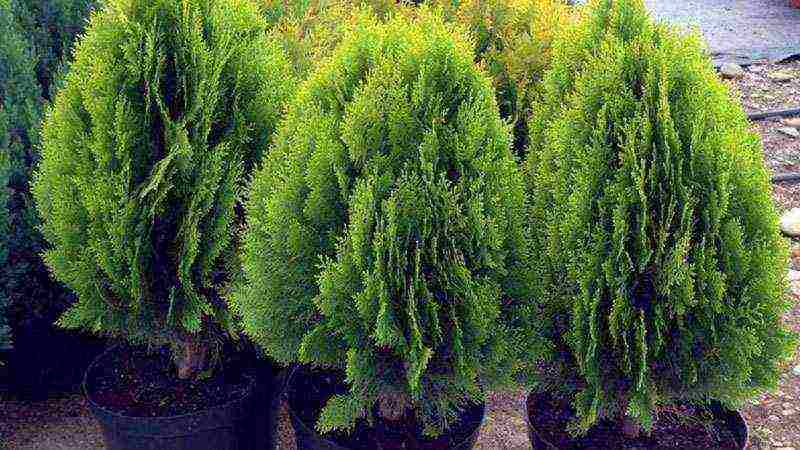
Principle, how to care for thuja at home, is enclosed in the following order:
- Planting a plant in a pot requires good drainage at the bottom of the pot. You can use a regular tray, which will also help remove excess moisture.
- The soil can be enriched with useful microelements by mixing four parts of sod land with two parts of coniferous. Only part of the sand is added to the mixture - the result is a soil suitable for planting seeds or cutting.
- The pot must be placed on the north or west window - this will provide diffused light suitable for normal growth for the shrub.
- For optimal cultivation, an already mature tree is provided with a temperature of 10-15 ° C. In the summer, it is necessary to take the pot with the plant to the balcony so that it receives its portion of air procedures.
- Watering is carried out as needed as soon as the soil dries out. It is important not to allow excessive moisture or dry out of the soil, all this will lead to the death of the plant.
- Thuja can calmly tolerate any whims of air humidity in the room. However, excessive "air drying" should not be allowed. It is better to maintain a moderate climate in relation to indoor humidity. In summer, in the heat, the plant should be sprayed.
- For the normal formation of a bush, the plant is pruned.
When growing thuja, one should not forget about timely feeding with special universal fertilizers, which are carried out in the spring and during the summer for a favorable and rapid growth.
From August to September, you can start propagation by cuttings.
Self-forming bonsai
Surprisingly, some growers give the bush-like thuja the shape of a bonsai tree. This is not easy to do. It is not enough just to pinch and cut the plant.
To form a bonsai, it is necessary to give the shrub an appropriate shape, subjecting its branches to a forced change in the direction of growth, slightly breaking them at the same time. The curved branch is fixed in a new direction and all branches are cut off.
After a while, the shrub will begin to form into a bonsai tree, where you should monitor the formation of the crown, constantly pruning.
Pay attention to this material - Barberry: planting and care, useful properties.
Diseases and pests
Proper care of the presented plant allows you to achieve an attractive green shrub.
If you make any mistakes, the thuja branches can thin out, and the rich green color will change to pale gray.
But this is not the worst thing that can happen to a plant. Much more dangerous is a fungal infection or an invasion of harmful insects, the fight against which can take a long time. The most common and dangerous diseases of thuja include:
You will be interested in this article - Black currant: planting and care in the open field.
- Fungus - appears in the form of spots characteristic of the fungus, often affecting young shoots. The shrub should be treated immediately. To begin with, all affected areas are completely cut off, and then you can resort to treatment with any antifungal solution.
- False shield - yellow spots form on the branches, which are often perceived as a real shield. To remove them, the plant should be treated with Rogor or Karbofos solutions.
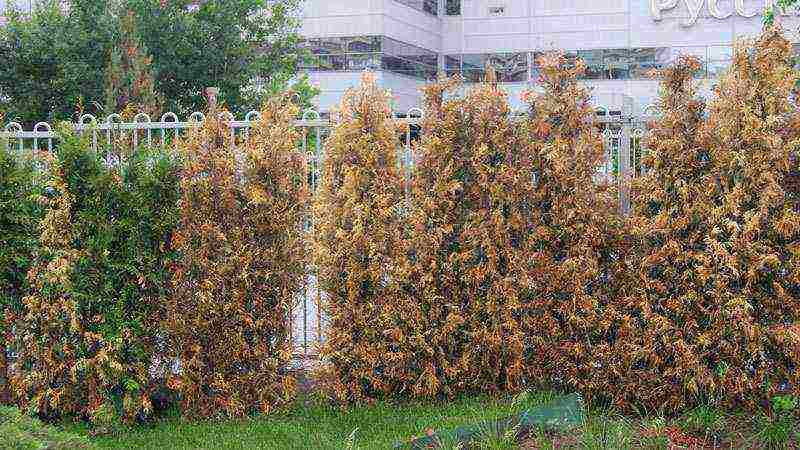
- Speckled moth - often appears when growing thuja in the open field. It manifests itself in the form of the transformation of branches into brown color and the withering away of the top of the tree. You can get rid of pests by treating the shrub with solutions containing pyrethroid.
- Aphids - leads to the fall of the needles from the bush. Here you can use Karbofos according to the instructions.
The correct cultivation of a coniferous plant at home or in the open field will give flower growers and gardeners great pleasure.
Such plants should be "kept" nearby, as thuja needles have excellent beneficial properties.
Thuja needles can be used to treat wounds, as a hemostatic agent, and also for colds.
Like the article ? Show it to your friends:
Thuja is an evergreen tree that is highly valued for its decorative effect at any time of the year. It is a great find for landscaping as a specimen plant and hedge formation. Growing a thuja from seeds is a fun process that brings significant economic benefits. For this, it is important to choose high-quality planting material and adhere to certain rules.
Selection of seeds for sowing

Young thuja bushes
When choosing this method of growing thuja, it is important for a gardener to know that it will take three to five years to grow small seedlings. The entire period of growing thuja until adulthood will require maximum care, and the application of certain rules of agricultural technology.
In addition, seedlings grown from seeds collected from the tree will retain only species characteristics and may not resemble the parent plant much. The parental traits can be fully preserved only with vegetative reproduction.
Another characteristic feature of thuja is the location of female flowers in the upper part of the crown, and male flowers at the bottom. This greatly complicates pollination and reduces the level of germination of thuja seeds, which grow singly or in mixed plantings.
For sowing, seeds of densely planted homogeneous varieties of thuja are ideal. Lumber cones are harvested from September to December, it is during this period that the embryo fully ripens.
A characteristic feature of thuja seeds is a rapid loss of germination during storage. Therefore, it is best to sow conifers in the same fall or spring after the cold stratification procedure.
After collecting, they are laid out on a dry surface in a room with diffused light.After two days, the cones will dry out and small brown-brown seeds will separate from them.
Thuja seeds can also be purchased at garden centers. For growing in personal plots, you need to choose unpretentious varieties with high resistance to diseases and pests. These qualities are possessed by the varieties: Smaragd and Brabant. They are distinguished by a high level of germination and easily endure the most severe frosts.
Soil preparation and sowing seeds
An effective and easy way to grow thuja with seeds is to sow before winter. So the seeds will go through the process of stratification in natural conditions. This gives them a great advantage: seedlings sprout earlier, are fast growing and endure the first winter more easily.
You can sow seeds directly into the ground or into prepared boxes. The second method has advantages: ease of care and control over the seedling. In addition, the container can always be moved to different places depending on climatic conditions.
The box for planting seedlings should be selected taking into account the comfort of young plants in the first year of development. The proportionality of future seedlings and capacity must be respected.

Thuja hedge
In containers that are too deep, the unrooted soil turns sour, which negatively affects the growth of the seedling. In low boxes, the roots of the plant begin to develop in width and intertwine with neighboring seedlings. This leads to severe pick damage, which conifers tolerate painfully.
In a thuja seedling, the root system in the first years of development lies at a shallow depth. Therefore, the best option for planting would be a box with a height of 10-12 cm.
A breathable and moisture-absorbing substrate is prepared from:
- peat,
- leafy land,
- river sand.
The components are mixed at a ratio of 2: 1: 0.5. 1 day before planting, the substrate is disinfected from mold germs, spilled with boiling water. The container is filled with soil mixture and shallow rows are drawn on the surface at a distance of 5 cm.
Seeds are evenly spread along the length of the hole and sprinkled with a thin layer of substrate. The surface is compacted and, if the soil is dry, watered. No watering is required in wet and cloudy weather.
Thuja seedlings care
Young thujas very painfully endure direct sunlight and this must be taken care of in advance, install a box with seedlings in a shaded place.
The ideal accommodation option is a place under the spreading crown of trees, which additionally protects from squally winds and heavy precipitation. There the sown seeds will undergo natural stratification under the snow.
In the spring, 10-20 days after the soil warms up to + 15 °, the thuja will give the first shoots. In the early stages of development, there is a very high risk of damage to seedlings by fungal diseases. Therefore, when the first sprouts appear, it is important to carry out prophylaxis - to treat them with fungicides. For this, seedlings and the surface of the substrate are sprayed with a solution of "Fundazol".

Thuja sprouts grown from seeds
During the growing season, seedlings must be provided with the necessary care:
Top dressing with mineral complexes every 15 days. For this, solutions of drugs are well suited: "Agricola", "Solution". When preparing the nutrient solution, it is necessary to use only half the dose recommended for adult plants.
Watering is carried out as the soil dries up. The substrate should be moderately moist, not dry out more than 3 cm.
It is necessary to monitor the aeration inside the container. To do this, the soil is loosened as the top layer dries up. Weeds are necessarily harvested; in confined spaces, the suppression of a cultivated plant is much stronger.
At the end of summer, thuja roots must be nourished with growth stimulants. For this, ½ dose of the drug "Kornevin" is used.
Before the onset of cold weather, the surface of the substrate under the seedlings must be mulched. For this, a 2-3 cm layer of peat is laid. Seedlings must be loosely wrapped in burlap, this will protect them from sunburn.An alternative is to spray with Purshate, which creates a protective film. Only this procedure will need to be carried out periodically.
An important moment for the development of strong roots is picking. It is carried out 2 months after germination. The seedling must be carefully removed from the substrate and pinched 1/3 of the central root. After that, young thuja are seated more spaciously.
One procedure is enough for thuja. Conifers recover for a very long time after this procedure, about 20-30 days. During this period, the growth of the seedling will slow down. If you make several dives, then the thuja will not have time to properly strengthen before the first winter season.
Thuja in the first year of development gives an increase of only 7 cm and bears little resemblance to an adult plant. The shape of the needles is more reminiscent of a juniper or decorative fir. The first branches with scaly needles appear only in autumn.
The second year of thuja development

Thuja in landscape design
If the seedlings are comfortable in the same place and the volume of the container allows, you can leave them there for another year. Large specimens that have overgrown the volume of the substrate must be transplanted. To do this, you can form a temporary ridge in partial shade.
The soil in the selected area is enriched, per 1 m2 is applied:
- humus 10 kg;
- wood ash 300 g;
- nitrophoska 40 g.
The plot is dug to a depth of 30 cm. Plants are planted at a distance of 30 cm from each other. When planting, it is important to monitor the level of the root collar, it should not deepen. It is necessary to spread the roots well so that there are no bends in the upper direction.
After that, the seedlings are abundantly watered and mulched with peat. Seedlings are looked after as in the previous year. For the next season, the thuja will grow to 50 cm, this is quite enough for transplanting a seedling to a permanent place.
An important tip: often when growing a plant with seeds, the shape of the crown changes. This is clearly visible in 2-3 years. To form a uniform hedge, you need to select plants with the same shape and density of needles. The leftover plants can be used as a specimen plant or to decorate ponds.
While watching the video, you will learn about the cultivation of thuja.
Thuja lends itself well to decorative haircuts. This is a fun process during which you can realize all your fantasies. Historical fact - the lifespan of thuja is many hundreds of years. Perhaps, more than one generation of people will admire the hedge created today.
Have you noticed a mistake? Select it and press Ctrl + Enter to tell us.
Thuja
The simplest and most convenient technology for thuja breeding is sowing seeds in the ground before winter. Seedlings come out strong, develop well. You can get any number of seedlings in a fairly short time. Here's how to do it:
Why is it convenient to propagate thuja by seeds
Thuja is winter-hardy and unpretentious. It is one of the best plants for hedges: thanks to the evergreen needles, it protects the garden from the cold winds in both summer and winter. But for a hedge, you need a large number of very expensive plants. Where to get so many seedlings if you don't want to incur extra costs?
Propagating thuja by seeds, you can get any number of seedlings in 3-4 years. And do not be afraid that in the first year of life, seedlings reach only 7 centimeters. After 2 years of cultivation, they will already grow up to 50 cm, and subsequently they will give an increase of about 30 cm per season.
How to prepare thuja seeds from cones Thuja seeds ripen in late August - early September. You need to collect seeds before the cones open.

Spread out the collected thuja cones in a thin layer to dry in a warm, dry place. As soon as the cones dry out and open, the seeds spill out freely from them. It is better not to pull with sowing: if you store thuja seeds at room temperature, after three months their germination rate sharply decreases. If you do decide to sow in spring, stratification (exposure to low temperatures) will be necessary for successful germination.
The easiest way is to sow thuja with freshly harvested seeds in the fall, leaving the crops to winter outside. Natural stratification increases the vigor of germination, seedlings emerge earlier than after spring sowing, require less worries, grow faster and endure the first wintering more successfully.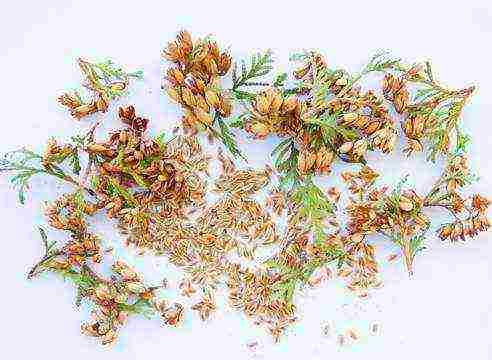
Sowing thuja seeds You can sow thuja directly into the ground on a specially designated garden bed, but it is better to sow seeds in a box. So it is more convenient to work, and it is easier to care for the seedlings: if necessary, the box can be rearranged to any place.
Fill the box with a mixture of turf or garden soil, peat and sand (1: 2: 0.5 parts). Level well over the entire surface and compact the soil in such a way that the side of the box rises above it by 2-3 cm.After that, it is necessary to mark the grooves at a distance of 5-6 centimeters.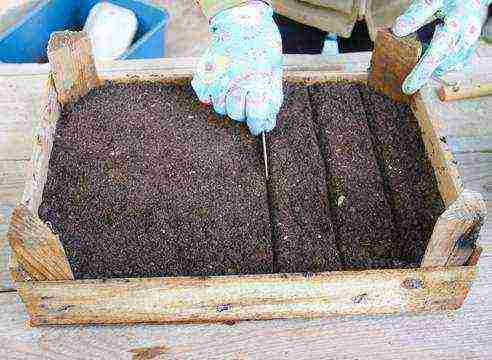
To make it easier to burrow the seeds, widen the grooves.
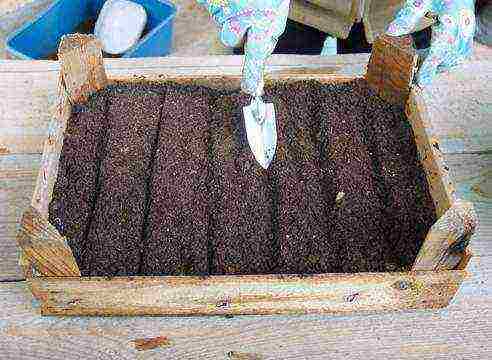
Spread the thuja seeds evenly along the entire length of the groove.

Fill the crops with soil mixture on top with a layer of about 1 cm. Compact the surface with a plank. If the weather is dry, water a little, but be careful not to float the seeds. Those seeds that do float should be sprinkled with a small amount of soil. No watering is required in wet weather.

How to care for thuja crops Install a box with sowing outdoors, preferably under the crown of trees: then the seedlings will not be in direct sunlight in the spring - for conifers, including thuja, it is dangerous. If there are animals on your site, then the crops must be covered with a film or non-woven covering material. After the snow has melted, make sure that the cover does not touch the surface of the soil.
In 2-3 weeks after the soil warms up to + 10 ... + 15 ° С, the thuja gives the first shoots. Thuja seedlings do not look like adult plants: their needles are needle-shaped, and not scaly, like in adult plants.
It may seem that instead of the thuja, another plant has grown from the seeds - for example, a spruce or a juniper. But do not be alarmed: after 2-3 months, the seedlings will have the first branches with real scaly needles.
Feed the plants every two weeks with a solution of a complete mineral fertilizer (nitrogen, phosphorus, potassium). You can use fertilizers "Solution", "Agricola" - they include trace elements (manganese, zinc, molybdenum, copper, boron). During the season, seedlings grow up to 7-8 cm and remain in the box for the winter.
If the crops are not very thickened, and the box is deep enough (or you sowed directly into the ground), then the crops can be left in the same place for another year. But more developed thuja seedlings are obtained if they are planted in a school (a garden bed) after the first wintering.
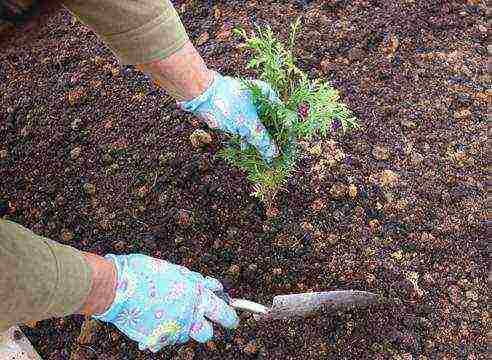
It is best to choose a place for a school in a light partial shade. Apply to the soil 1 sq. m: humus (1 bucket), nitroammofosku (40 g) and wood ash (250-300 g), dig well onto the bayonet of the shovel.
Thuja tolerates transplantation well at any age. It is planted in a school for growing up according to a 30x30 cm scheme.
When planting, make sure that the root collar remains on the damage of the soil, deepening leads to damping. As a result, thuja turns yellow and usually dies.
More: why does thuja turn yellow?
After planting, water and mulch with peat. Feed every 2-3 weeks in the same way as in the previous season, water in dry weather, loosen the soil after watering and remove weeds at the same time. In the third year of cultivation, when the thuja grown from seeds reaches a height of 50 centimeters, it can be planted in a permanent place.
For a hedge, a homogeneous planting material is needed, but when growing thuja from seeds, forms are split: seedlings from sowing are obtained with different outlines and density of crowns. There is a solution to this problem. At the age of 2-3 years, the future shape of the crown is already clearly visible in thuja seedlings. You can easily select the required amount of uniform planting material for a hedge or other purposes.In addition, the thuja tolerates a haircut very well, and the desired hedge shape can be obtained, even if the seedlings are slightly different.
Among the variety of conifers, thuja is especially loved by summer residents, owners of private houses. This is not surprising - thuja is frost-resistant, unpretentious, aesthetically attractive. Planting and care in the open field will not require significant work from the summer resident, but its presence on the site will be positive from any point of view. It is great for the formation of hedges, with its help you can create unique green shapes for landscape design of the site, arrange paths.
This tree, like its coniferous cousins, exudes a wonderful aroma, enriches the air with useful phytoncides. Thuja carries a lot of positive qualities.

Thuja differs from pine or spruce in that it has no needles, its branches are covered with small green scales, soft, pleasant to the touch. It is tacitly called the "royal tree" - it is well deserved. We will consider the nuances of planting, caring for the coniferous beauty thuja, so that it takes root on your site too.
↑ to contents ↑ Thuja tree - selection of seedlings
If you do not plan to reproduce thuja independently, then you can purchase ready-made, grown seedlings. They can be bought at ephedra nurseries or in a specialized store. There, among the declared assortment, you will choose the desired variety, buy a healthy tree, adapted to the local climate.
They can be bought at ephedra nurseries or in a specialized store. There, among the declared assortment, you will choose the desired variety, buy a healthy tree, adapted to the local climate.
Small thuja from nurseries vary in size and age. If you have a small seedling, then it will not be difficult to "grow" it yourself until it is planted in a permanent place of growth. You can also purchase a large copy, ready for the decoration of the site or the local area.
When choosing, always pay attention to the conditions of the plants, the degree of soil moisture in the containers, the strength of the coniferous scales on the branch. The branches of the seedlings should be elastic, the needles should not crumble, they should not have any spots or signs of disease. Upon arrival home, hurry to transplant them to a shaded place, water.
↑ back to contents ↑ Planting thuja in the ground
Thuja will perfectly take root on your site at any time of the year, except in late autumn or winter. Experienced gardeners advise exactly the spring period - April, May. Planted in spring, it will hurt less, grow faster, and adapt better to the environment.
The landing site should be slightly shaded, consider this factor when planning the landscape design of the site. In direct sunlight, the tree will wither, and subsequently it will be worse to endure the winter cold. In a completely dark place, thuja will slowly develop, the branches will not be lush, bright. The ideal territory for it will be a windless section of the site, with light shading, close occurrence of groundwater.

Thuja - planting and leaving, phased actions:
- First, we dig a rather deep hole - 80-100 cm deep, with the same diameter (if you, of course, have a large seedling, and not the one in the photo above). The deepening should be such that a tree with an earthen lump can freely enter there. At the bottom we pour a little earth mixed with wood ash or other organic fertilizer.
- We put it in a hole, while its root collar should be located at the same level with the soil surface.
- Mix the dug earth with sand, peat (1: 1), fill a depression with a seedling with this mixture, and then slightly trample.
The distance between the trees should be determined according to the characteristics of the variety, since thuja are very small and, conversely, very tall. Small trees can be planted a meter apart, large ones - about 4-5 meters. Some varieties of thuja reach 15-20 meters in height, and their crown grows in breadth up to 3-4 meters (for example, thuja western Brabant).For full development, such a tree needs space, but when decorating alleys, green corridors, hedges, thuja are planted at a distance of 1 meter, regardless of the variety and type.
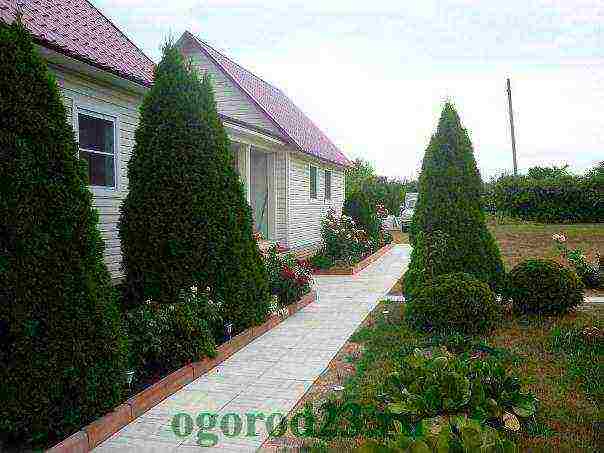 Tui Western Smaragd and globular Danica↑ back to contents ↑ How to care for thuja
Tui Western Smaragd and globular Danica↑ back to contents ↑ How to care for thuja
Competent care of this ephedra means watering, feeding, loosening the trunk circle, and forming a crown. After the tree is planted at its permanent place of residence, primary feeding is done. For these purposes, natural growth stimulants are often used (most gardeners choose "Epin"). The components of such dressings contribute to better rooting of the tree, improve resistance to diseases. In the spring, you can feed it with potassium-phosphorus supplements, it is better to do this twice, the break between fertilizers should be 10-15 days.
In spring, the frequency of irrigation is influenced by the amount of rain, with the onset of summer it is enough 2 times a week, in the spring - 1 time. If the rains are frequent, then there is no need to water, there will be enough rain moisture. Thuja requires high-quality watering at all stages of life (seedling, adult tree), while the crown also loves irrigation. In order for the branches to be elastic, shiny, to please you with the brightness of green shades, the minimum amount of water for the root area should be 10 liters per watering (once a week, if the summer is very dry, then up to 3 times). Determine the lack of moisture by the state of the top of the thuja - it begins to turn yellow. It is better to water the trees early in the morning or in the evening.
Tuya is very fond of irrigating the crown, for these procedures, the acquisition of a special nozzle becomes relevant. From such sprinkling, dust is washed off, a fresher appearance of the tree is provided, a pleasant coniferous aroma begins to stand out. Do not be afraid to overdo it with irrigation, 1-2 times a day will only benefit thuja.
Returning to fertilizers, it is worth noting that too frequent fertilizing for thuja is not required. Special mineral compositions for conifers (for example, "Fertika") or compost, which has already become a classic additive, is sufficient to use twice a season - in spring and summer. Fertilizers are applied during loosening: they are laid out in the near-trunk circle, and during plowing they are mixed with the top layer of the soil. In summer, the additive can be diluted with water and used for irrigation.
The near-trunk area must be periodically cleaned of weeds, loosened, mulched with sawdust or compost. Decoratively painted sawdust (they are painted with natural ingredients) or nutshells look very attractive. Mulching creates some barrier to weeds, retains moisture, and improves the condition of the tree as a whole.
As for haircuts or artistic pruning, it is better not to touch it for the first two years of a tree's life, it should take root in its place. You can start caring for the crown from the third year from the moment of planting. Initially, dried, weak branches are removed, and the degree of density is determined. Excessive thinning negatively affects the decorative qualities of the tree, everything should be in moderation.
The main pruning is carried out in April, and then only the shape is corrected. For high-quality air circulation, maintaining the "vigorous" appearance of thuja, gardeners recommend removing all branches of annual growth.
If the artistic intention requires the tree to grow in breadth, then only the upper part of the crown should be trimmed. You can create various geometric shapes, columns, figures of animals or fairy-tale characters from tui. For beginner gardeners, it is quite easy to give the crown of a tree the shape of a ball, cascade, border. Trimming or pruning is best done in dry weather.
↑ to contents ↑ Tuya - preparation for winter
For colder regions of the country, frost-resistant varieties of tui (western) should be chosen. Despite their unpretentiousness, they also require preparation for the cold season.In the fall, it is necessary to provide the trees with abundant watering, since even in winter the thuja continues to develop, albeit at a slower pace.
In the first years of life, young representatives must be insulated. With the help of a dense plastic film, non-woven spunbond or other suitable covering material, a kind of cocoon is formed, which will retain heat and let the sun's rays through. You can even buy special covers designed for this very purpose, they are sold by the garden departments of supermarkets or online stores.
For the winter, the roots are covered with fallen leaves, which are harvested with the onset of spring, as soon as the upper layer of the earth thaws. The overgrown crowns of adult thujas are neatly tied with a wide ribbon to prevent the accumulation of snow on the branches.
To please the eye, there was a healthy thuja, planting and care in the open field should be done competently, in a timely manner. This tree is quite unpretentious, but the result of simple care is expressed not only by its external beauty, decoration of the territory. A green hedge made of thuja will absorb noise from the street, neighboring territories, and also protect your site from prying eyes.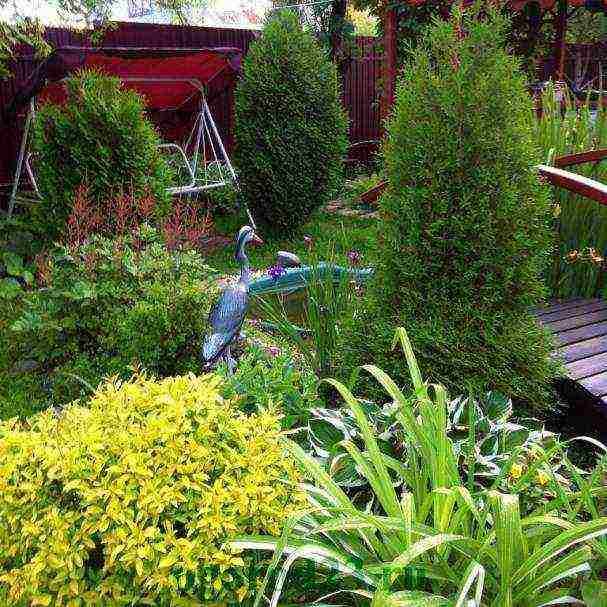
The simplest and most convenient technology for thuja breeding is sowing seeds in the ground before winter. Seedlings come out strong, develop well. You can get any number of seedlings in a fairly short time. Here's how to do it:
Why is it convenient to propagate thuja by seeds
Thuja is winter-hardy and unpretentious. It is one of the best plants for hedges: thanks to the evergreen needles, it protects the garden from the cold winds in both summer and winter. But for a hedge, you need a large number of very expensive plants. Where to get so many seedlings if you don't want to incur extra costs?
Propagating thuja by seeds, you can get any number of seedlings in 3-4 years. And do not be afraid that in the first year of life, seedlings reach only 7 centimeters. After 2 years of cultivation, they will already grow up to 50 cm, and subsequently they will give an increase of about 30 cm per season.
How to prepare thuja seeds from cones Thuja seeds ripen in late August - early September. You need to collect seeds before the cones open.
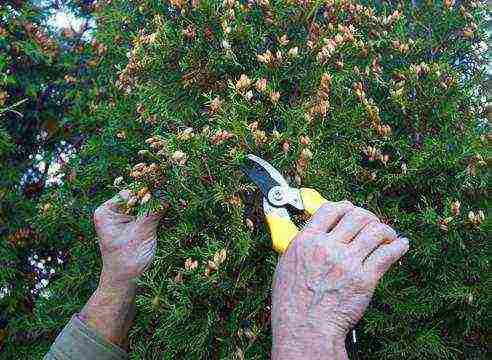
Spread out the collected thuja cones in a thin layer to dry in a warm, dry place. As soon as the cones dry out and open, the seeds spill out freely from them. It is better not to pull with sowing: if you store thuja seeds at room temperature, after three months their germination rate sharply decreases. If you do decide to sow in the spring, stratification (exposure to low temperatures) will be necessary for successful germination.
The easiest way is to sow thuja with freshly harvested seeds in the fall, leaving the crops to winter outside. Natural stratification increases the vigor of germination, seedlings emerge earlier than after spring sowing, require less worries, grow faster and endure the first wintering more successfully.
Sowing thuja seeds You can sow thuja directly into the ground on a specially designated bed, but it is better to sow seeds in a box. So it is more convenient to work, and it is easier to care for the seedlings: if necessary, the box can be rearranged to any place.
Fill the box with a mixture of turf or garden soil, peat and sand (1: 2: 0.5 parts). Level well over the entire surface and compact the soil in such a way that the side of the box rises 2-3 cm above it. After that, grooves should be marked at a distance of 5-6 centimeters.
To make it easier to burrow the seeds, widen the grooves.
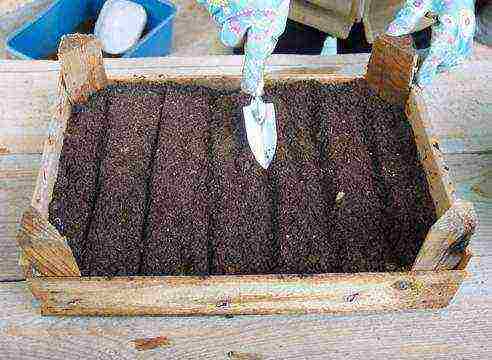
Spread the thuja seeds evenly along the entire length of the groove.

Fill the crops with soil mixture on top with a layer of about 1 cm. Compact the surface with a plank. If the weather is dry, water a little, but be careful not to float the seeds. Those seeds that do float should be sprinkled with a small amount of soil. No watering is required in wet weather.
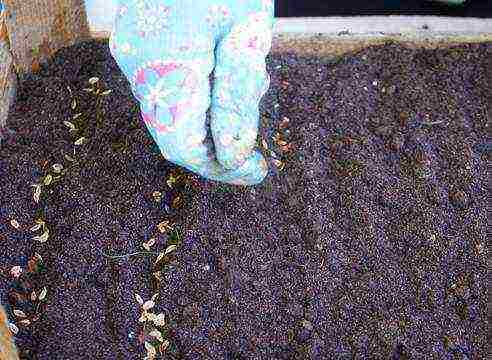
How to care for thuja crops Install a box with sowing outdoors, preferably under the crown of trees: then the seedlings will not be in direct sunlight in the spring - for conifers, including thuja, it is dangerous. If there are animals on your site, then the crops must be covered with a film or non-woven covering material. After the snow melts, make sure that the cover does not touch the soil surface.
In 2-3 weeks after warming up the soil to + 10 ... + 15 ° С, thuja gives the first shoots. Thuja seedlings do not look like adult plants: their needles are needle-shaped, and not scaly, like in adult plants.
It may seem that instead of the thuja, another plant has grown from the seeds - for example, a spruce or a juniper. But do not be alarmed: after 2-3 months, the seedlings will have the first branches with real scaly needles.
Feed the plants every two weeks with a solution of a complete mineral fertilizer (nitrogen, phosphorus, potassium). You can use fertilizers "Solution", "Agricola" - they include trace elements (manganese, zinc, molybdenum, copper, boron). During the season, the seedlings grow up to 7-8 cm and remain in the box for the winter.
If the crops are not very thickened, and the box is deep enough (or you sowed directly into the ground), then the crops can be left in the same place for another year. But more developed thuja seedlings are obtained if they are planted in a school (a garden bed) after the first wintering.
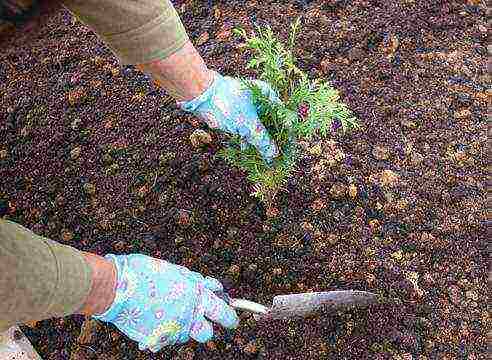
It is best to choose a place for a school in a light partial shade. Apply to the soil 1 sq. m: humus (1 bucket), nitroammophoska (40 g) and wood ash (250-300 g), dig well onto the bayonet of a shovel.
Thuja tolerates transplantation well at any age. It is planted in a school for growing up according to a 30x30 cm scheme.
When planting, make sure that the root collar remains on the damage of the soil, deepening leads to damping. As a result, thuja turns yellow and usually dies.
More: why does thuja turn yellow?
After planting, water and mulch with peat. Feed every 2-3 weeks in the same way as in the previous season, water in dry weather, loosen the soil after watering and remove weeds at the same time. In the third year of cultivation, when the thuja grown from seeds reaches a height of 50 centimeters, it can be planted in a permanent place.
For a hedge, a homogeneous planting material is needed, but when growing thuja from seeds, forms are split: seedlings from sowing are obtained with different outlines and density of crowns. There is a solution to this problem. At the age of 2-3 years, the future shape of the crown is already clearly visible in thuja seedlings. You can easily select the required amount of uniform planting material for a hedge or other purposes. In addition, the thuja tolerates a haircut very well, and the desired shape of the hedge can be obtained, even if the seedlings are slightly different.


